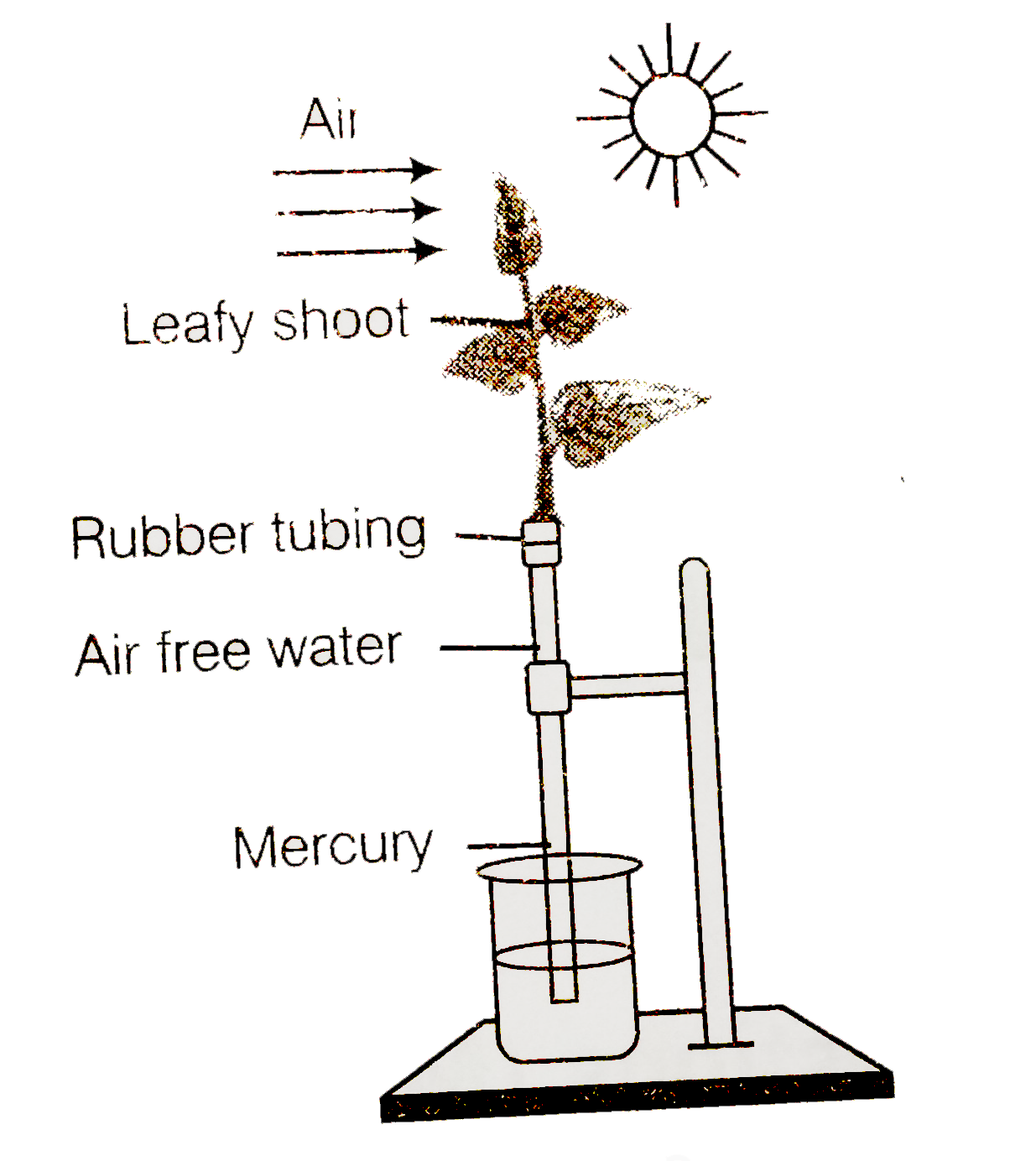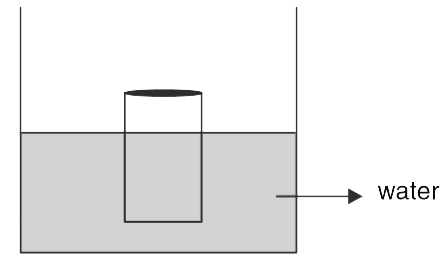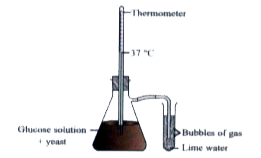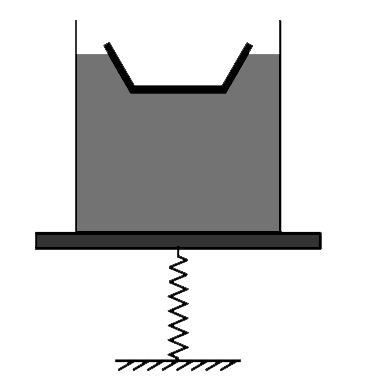Comment on the experimental setup.

(a) What does the setup demonstrate ?
(b) What will happen to the level of water if a blower is placed close to setup ?
(c) Will the mercury level fluctuate (go up/down) if phenyl mercuric acetate is sprayed on leaves ?
(a) set up demonstrate the phenomneon of transpiration
(b) The level of mercury will go up due to increased transpriation
(c ) No fluctuation wil be there as the transpiration willl stop due to closure of stomata
Topper's Solved these Questions
- BOOK - PRADEEPCHAPTER - TRANSPORT IN PLANTS EXERCISE - Analytical Question with Answer20videos
TRANSPORT IN PLANTS
- BOOK - PRADEEPCHAPTER - TRANSPORT IN PLANTS EXERCISE - Practice Question (Multiple Choice Question )62videos
TRANSPORT IN PLANTS
- BOOK - PRADEEPCHAPTER - TRANSPORT IN PLANTS EXERCISE - ADDITIONAL QUESTION (Short Answer Question )28videos
TRANSPORT IN PLANTS
- BOOK - PRADEEPCHAPTER - THE LIVING WORLDEXERCISE - ASSERTION-REASON TYPE QUESTIONS11videos
THE LIVING WORLD
Similar Questions
A student focuses the image of a candle flame, placed at about 2 m from a convex lens of focal length 10 cm, on a screen. After that, he moves gradually the flame towards the lens and each time its image on the screen.
(a) In which direction does he move the lens to focus the flame on the screen?
(b) What happens to the size of the image of the flame formed on the screen ?
(c ) What difference is seen in the intensity (brightnees) of the image of the flame on the screen ?
(d) What is seen on the when the flame is very close (at about 5 cm) to the lens ?View SolutionTo find the image-distance for varying object-distance in case of a convex lens, a student obtains on a screen a sharp image of a bright object placed very far from the lens. After that he gradually moves the object towards the lens and each time focuses its image of the screen.
(a) In which direction-towards or away from the lens, does he move the screen to focus the object?
(b) What happens to the size of image - does it increase or decrease ?
(c ) What happens when he moves the object very close to the lens ?View SolutionTo find the image-distance for varying object-distance in case of a convex lens, a student obtains on a screen a sharp image of a bright object placed very far from the lens. After that he gradually moves the object towards the lens and each time focuses its image of the screen.
(a) In which direction-towards or away from the lens, does he move the screen to focus the object?
(b) What happens to the size of image - does it increase or decrease ?
(c ) What happens when he moves the object very close to the lens ?View SolutionTo find the image-distance for varying object-distances in case o fa convex lens, a student obtains on a screen a sharp image of a bright object places very far from the lens. After that he gradually moves the object towards the lens and each time focuses its image on the screen.
(a) In which direction-towards or away from the lens, does he move the screen to focus the object ?
(b) What happens to the size of image - does it increase or decrease?
(c ) What happen when he moves the object very close to the lens ?View SolutionA cyclindrical ice block is floating in water 10% of its total volume is outside water. Kerosene oil (relative density=0.8) is poured slowly on top of water in the container. Assume that the oil does not mix with water. Height of the ice cylinder is H.

(a) As kerosene is poured, how does the volume of ice block above the water level change?
(b) What is the thickness of kerosene layer above the water when 20% of the volume of the ice block is above the water surface?
(c) Find the ratio of voume of ice block is kerosene to its volume in water after the kerosene layer rises above the top surface of ice and the block gets completely submerged. Neglect any melting of ice.View SolutionStudy the following experimental setup. Answer the questions that follow.
The set up was left for 2 days. What do you notice in the test tube having lime water solution? Justify
 View Solution
View Solution(i) A toy boat made of steel is floating in a beaker having water. The beaker is placed on a spring balance. The boat tilts and sinks into water.
(a) Will the level of water in the beaker go up or fall down?
(b) Will the reding of spring balance decrease or increase?

(iii) You are in a boat on a calm lake. There is a floating log near you . You pick the log and put it into the boat. What happesn to the level of water in the lake? Does it rise or fall?View SolutionRead the passage and answer the following questions.
Tides are the rise and fall of sea levels caused by the combined effects of the gravitational forces exerted by moon and sun and rotation of earth. High tide and low tides are two types of tides which occur at different times at different places. The level of water in the sea changes because of the gravitational force exerted by the moon. Water directly under the moon gets pulled towards the moon and the level of water goes up causing high tide at place. At two places on the Earth at 90∘ from the place of the high tide, the level of water is minimum and low tide occur.
a. What is tide?
b. How high tide and low tide occur?
c. How do the level of water change in the sea?View SolutionThe water level in a vertical glass tube 1.00 m long can be adjusted to any position in the tube. A tuning fork vibrating at 900 Hz is held just over the open top end of the tube, to set up a standing wave of sound in the air-filled top portion of the tube. (That airfilled top portion acts as a tube with one end closed and the other end open.) (a) For how many different positions of the water level will sound from the fork set up resonance in the tube's air-filled portion? What are the (b) least and (c ) second least water heights in the tube for resonance to occur?
View SolutionIn a village, farmers started cultivating crops all around a lake which was always filled with water. They added lot of materials W to the soil in their fields to increase the yield of crops. Soon they found that the whole surface of water in the lake was covered with a green layer made up of tiny organisms X. After some time, the fish present in the lake started dying in large numbers they could not get sufficient Y due to a process Z which had occurred in lake water and drained out all the Y present in the water of lake.
(a) What do you think materials W are ?
(b) Name (i) X, and (ii) Y.
(c ) What is the process Z known as ?
(d) What happens during the process Z which uses up all the Y present in lake water ?
(e) What does this example tell us about the use of materials like W ?View Solution

